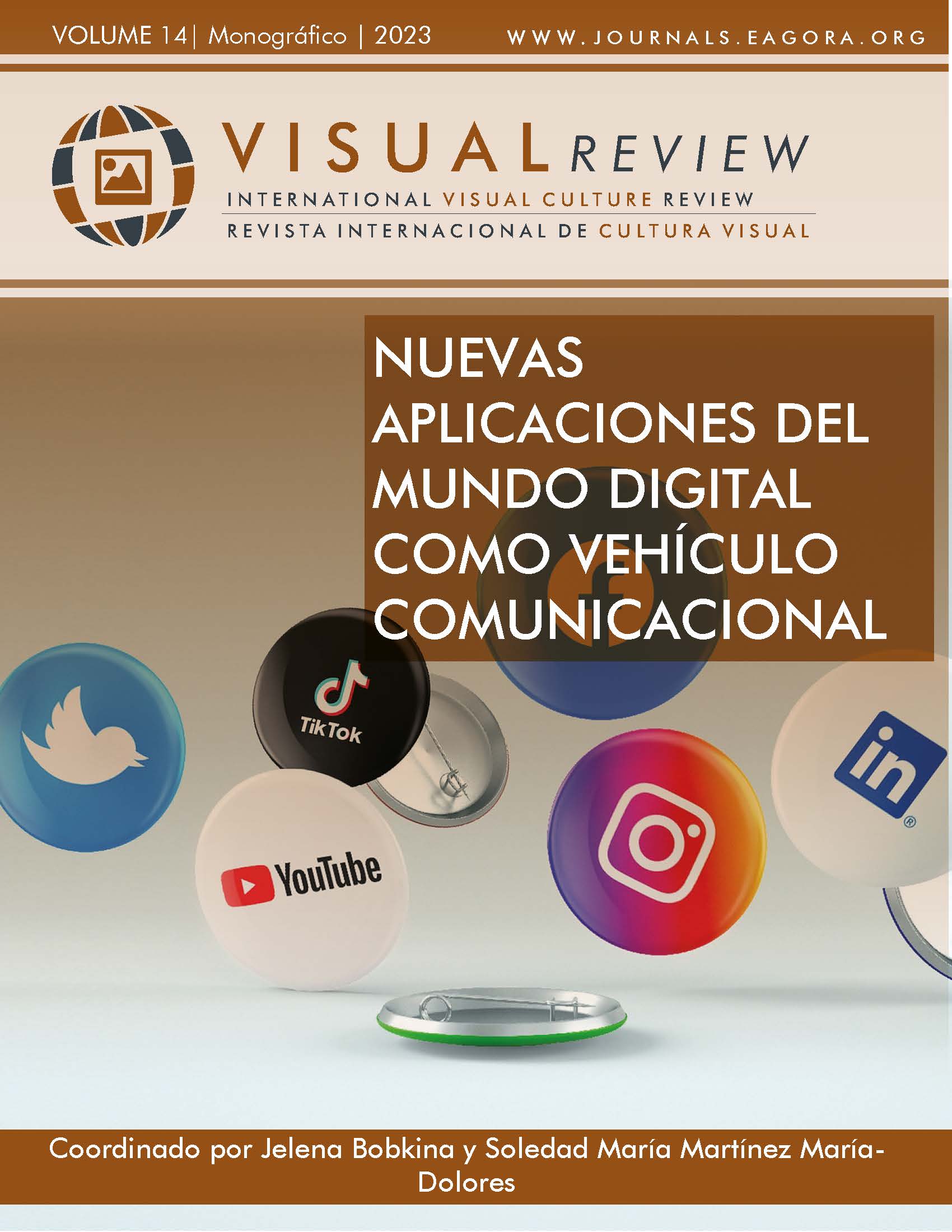Algoritmografía, hito y fenómeno en la producción de imágenes fijas en la era digital
Resignificación de la noción de la imagen fotográfica y proyección del medio en un contexto de producción de imágenes con inteligencia artificial y machine learnin
DOI:
https://doi.org/10.37467/revvisual.v10.4607Palabras clave:
Posfotografía, Big data, Deep learning, Comunicación, Algoritmos, Fotografía, Inteligencia ArtificialResumen
La imagen fija y sus modelos de producción han evolucionado de manera significativa a lo largo de estos últimos años. Las imágenes pueden ser, con la tecnología actual, producidas por inteligencias artificiales (IAs) y con técnicas como la creación de algoritmos y machine learning. El presente artículo trata de indagar en la comprensión de tal fenómeno, analizando el rol de la imagen en la actualidad y sus métodos de captación y representación para diferentes fines (las grafías) y tratando de contribuir a establecer un modelo que nos llevaría al concepto de algoritmografía como hito en la producción de imágenes.
Descargas
Estadísticas globales ℹ️
|
1773
Visualizaciones
|
1013
Descargas
|
|
2786
Total
|
|
Citas
Barthes, R. (1965). Elements de sémiologie.
Borgo, M., Licata, M., & Iorio, S. (2016). Post-mortem Photography: the Edge Where Life Meets Death?. Human and Social Studies, 5(2), 103-115. https://n9.cl/mew8a DOI: https://doi.org/10.1515/hssr-2016-0016
Chella, A., Frixione, M., & Gaglio, S. (1997). A cognitive architecture for artificial vision. Artificial Intelligence, 89(1-2), 73-111. www.sciencedirect.com/science/article/pii/S0004370296000392 DOI: https://doi.org/10.1016/S0004-3702(96)00039-2
Dot CSV (2022). ¿Tiene la IA de Google CONSCIENCIA? NO, pero me preocupa... (LaMDA). Youtube. Universidad Politécnica de Valencia. www.youtube.com/watch?v=Ko7WFx4rUw0
Dyck, P. K. (1968). Do Androids Dream of Electric Sheep? Print (hardback & paperback)
Fontcuberta, J. (2016a). La furia de las imágenes: notas sobre la posfotografía.
Fontcuberta, J. (2016b). La posfotografía explicada a los monos. Porto Arte: Revista de Artes Visuais, 21(35). www.seer.ufrgs.br/PortoArte/article/view/73723 DOI: https://doi.org/10.22456/2179-8001.73723
Gabel, V. P. (2017). Artificial vision. Springer. https://link.springer.com/book/10.1007/978-3-319-41876-6?noAccess=true DOI: https://doi.org/10.1007/978-3-319-41876-6
Hafsteinsson, S. B. (1999). Post-mortem and funeral photography in Iceland. History of photography, 23(1), 49-54. www.tandfonline.com/doi/abs/10.1080/03087298.1999.10443798 DOI: https://doi.org/10.1080/03087298.1999.10443798
Humayun, M. S., & de Juan, E. (1998). Artificial vision. Eye, 12(3), 605-607. www.nature.com/articles/eye1998151 DOI: https://doi.org/10.1038/eye.1998.151
Linkman, A. (2006). Taken from life: Post-mortem portraiture in Britain 1860–1910. History of photography, 30(4), 309-347. www.tandfonline.com/doi/abs/10.1080/03087298.2006.10443484 DOI: https://doi.org/10.1080/03087298.2006.10443484
Morla, J. (2022). LaMDA, Google y cuando jugar con una inteligencia artificial es posible. El País. 2022-06-24. https://n9.cl/jekra
Mendelyté, A. (2012). Death (in the eye) of the beholder: An encounter with Victorian post-mortem photography. Synaesthesia: Communication across Cultures, 1(3), 84-90. https://n9.cl/a1piq
Mitchell, W.J. (1992). The Reconfigured Eye. Visual Thruth in the Post-Photographic Era. MIT Press.
Perice, C. S. (1878). How to Make our Ideas Clear. Illustrations of the Logic of Science II.
Peirce, C.S. (1894). What Is a Sign?
Scott. R. (1982). Blade Runner.
Shannon, C.E. (1948). A Mathematical Theory of Communication, Bell System Technical Journal, 27, 379–423 & 623–656.. DOI: https://doi.org/10.1002/j.1538-7305.1948.tb00917.x
Thomas, H. (2001). The Spanish Civil War: Revised Edition. Modern Library.
Toro-Peralta, K. A., & Grisales-Vargas, A. L. (2021). Posfotografía: de la imagen del mundo al mundo de las imágenes. Arte, Individuo y Sociedad, 33(3), 899-916. https://revistas.ucm.es/index.php/ARIS/article/download/70435/4564456557159 DOI: https://doi.org/10.5209/aris.70435
Villafañe, J. (1985). Escala de iconicidad de Justo Villafañe. Recuperado de: http://catarina.udlap.mx/u_dl_a/tales/documentos/mdi/davila_c_me/apendiceC.pdf
Villafañe, J. (2006). Introducción a la teoría de la imagen. Pirámide. https://bit.ly/3hScU1L
Wolf, M. (2011). Serie Fuck you. Street view [Fotografía]. https://photomichaelwolf.com/#fuck-you/7
Descargas
Publicado
Cómo citar
Número
Sección
Licencia
Los autores/as que publiquen en esta revista aceptan las siguientes condiciones:
- Los autores/as conservan los derechos de autor.
- Los autores/as ceden a la revista el derecho de la primera publicación. La revista también posee los derechos de edición.
- Todos los contenidos publicados se regulan mediante una Licencia Atribución/Reconocimiento-SinDerivados 4.0 Internacional. Acceda a la versión informativa y texto legal de la licencia. En virtud de ello, se permite a terceros utilizar lo publicado siempre que mencionen la autoría del trabajo y a la primera publicación en esta revista. Si transforma el material, no podrá distribuir el trabajo modificado.
- Los autores/as pueden realizar otros acuerdos contractuales independientes y adicionales para la distribución no exclusiva de la versión del artículo publicado en esta revista (p. ej., incluirlo en un repositorio institucional o publicarlo en un libro) siempre que indiquen claramente que el trabajo se publicó por primera vez en esta revista.
- Se permite y recomienda a los autores/as a publicar su trabajo en Internet (por ejemplo en páginas institucionales o personales), una vez publicado en la revista y citando a la misma ya que puede conducir a intercambios productivos y a una mayor y más rápida difusión del trabajo publicado (vea The Effect of Open Access).













